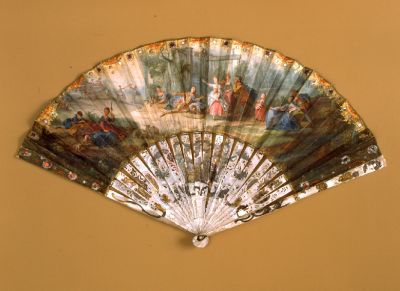
Fan - with the scene Angelica's wedding
| Accession Nr.: | 19806 |
|---|---|
| Date of production: |
ca. 1740
|
| Place of production: | France |
| Materials: | mother-of-pearl sticks; parchment; silver foil |
|---|---|
| Techniques: | carved; gilded; painted; pierced |
| Dimensions: |
height: 27 cm
width: 49 cm
|
The leaf, which is bordered by gilt paint, coloured flowers, red metal foil, and mother-of-pearl facets, depicts a garden with a fountain. In the foreground a knight in armour is throwing himself before a young lady arriving with her entourage. To the right of the group is a pair of lovers. To the left a young shepherdess sits beside her lambs, while behind her sprawls a young boy. On the left in the background a young couple is dancing beside them is a company around a table.
A painting by Charles-Antoine Coypel (1694-1752), custodian of the royal collection of paintings and drawings, served as the basis for the fan. The original work was one of the pictures made for the so-called "Details d'Opera" tapestry series, which consisted of four works. The themes for these tapestries, which were intended for the queen's apartments, were supplied by two highly successful operas by Jean-Baptiste Lully (1632-1687): Roland, which was premiered in 1685, and Armide, which was staged two years later. The sources of their librettos were two very well known and influential Renaissance epics: Orlando furioso by Ludovico Ariosto and Gerusalemme liberata by Torquato Tasso, respectively (Lee 1940).
The first work in the "Details d'Opera" series was "Roland", which recalls the moment in Act iy Scene 4 when the disappointed Roland, who is in love with Angelica, seeks refuge in madness. In 1737 Pierre-Louis Surugue (1716—1772) made an engraving based on the picture, thus facilitating the further popularisation of the work and the widespread use of the composition in other branches of the arts. In this way it was used by an unknown Paris fan-maker around the year 1740, not long after the engraving appeared. On the fan leaf the scene is enacted in a frame containing a fountain an inscription on the trunk of one of the trees in the garden - Rolan / cherche / angelique - provides the key to the identification of the depiction.
The painting on the fan follows the original picture only in the most perfunctory manner, utilising just two of its most characteristic motifs: the figure of Orlando falling on his knees before Angelica and the couple in the background dancing. The dignified pose of the two protagonists has become a charming one and the members of Angelica's entourage and the animated participants in the populous and mobile groups watching the event have been reduced to the number and type of figures usually found in fan pictures. On the reverse, on a small island, a young man with his sweetheart in his lap is writing their names on a monument surmounted by an urn: an / gelique / et / medor. From behind bushes and from among clouds Amor is spying on them, holding him quiver on high in triumph. The fan may have been a keepsake recalling a theatre performance, since Lully's works remained on the repertoire for longer than any before them. The references to love and marriage, however, rather suggest that the fan was an engagement present.
Literature
- Maros Donka Szilvia: Bájos semmiségek. Az Iparművészeti Múzeum legyezőgyűjteménye (1700-1920). Balassi Kiadó - Iparművészeti Múzeum, Budapest, 2002. - Nr. 20.
- Szerk.: Szilágyi András, Péter Márta: Barokk és rokokó. Az európai iparművészet stíluskorszakai. Iparművészeti Múzeum, Budapest, 1990. - Nr. 6.204. (Maros Donka Szilvia)

